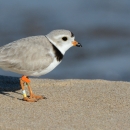In order for habitat to be physically and biologically suitable for piping plovers, it must have a total shoreline length of at least 0.2 km (0.12 mi) of gently sloping, sparsely vegetated (less than 50 percent herbaceous and low woody cover) sand beach with a total beach area of at least 2 hectares (ha) (5 acres (ac)).
Appropriately sized sites must also have areas of at least 50 meters (m) (164 feet (ft)) in length where (1) the beach width is more than 7 m (23 ft), (2) there is protective cover for nests and chicks, and (3) the distance to the treeline (from the normal high-water line to where the forest begins) is more than 50 m (164 ft). Beach width is defined as the distance from the normal high-water line to the foredune (a low barrier dune ridge immediately inland from the beach) edge, or to the sand/vegetation boundary in areas where the foredune is absent. The beach width may be narrower than 7 m (23 ft) if appropriate sand and cobble areas of at least 7 m (23 ft) exist between the dune and the treeline.
Protective cover for nests and chicks consists of small patches of herbaceous vegetation, cobble (stones larger than 1 cm (0.4 inches (in)) diameter), gravel (stones smaller than 1 cm (0.4 in diameter), or debris such as driftwood, wrack, root masses, or dead shrubs. These areas must have a low level of disturbance from human activities and from domestic animals.
As the nesting season progresses, the level of disturbance tolerated by piping plovers increases. A lower level of disturbance is required at the beginning of the nesting period during nest site selection, egg laying, and incubation. Beach activities that may be associated with a high level of disturbance include, but are not limited to, walking pets off leash, loud noise, driving all-terrain vehicles (ATVs), or activities that significantly increase the level of people using the beach. The level of disturbance is relative to the proximity to the nest, intensity, and frequency of these and other similar activities.

